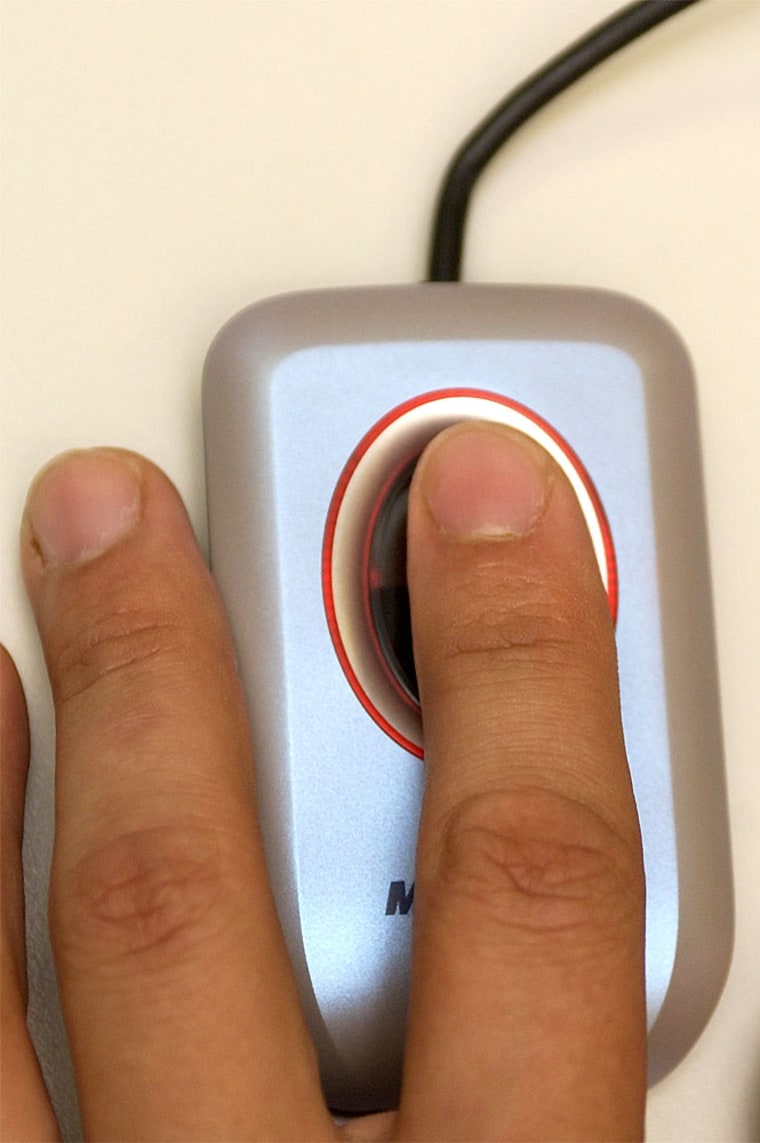Spend time online and odds are you'll have to type a username and password to check your e-mail, access your bank account or read a newspaper story.
Enter Microsoft Corp.'s new fingerprint-recognition technology for personal computers running its Windows XP operating system. The device promises to relieve the drudgery of keeping track of passwords and having to retype them again and again. Your fingerprints serve as a shortcut.
To a large degree, the Microsoft Fingerprint Reader worked as promised, making quick work of signing into most of the Web sites and software applications I tried.
(MSNBC is a Microsoft - NBC joint venture.)
Like other devices based on biometrics -- the use of technology to recognize physical traits -- the Microsoft reader scans the unique skin patterns on a finger. The device's software keeps the image as a reference and bars others from triggering the automated passwords needed to access Web sites and computer programs.
Curiously, Microsoft warns that the Fingerprint Reader should not be trusted to secure access to corporate networks or to protect sensitive data, such as financial information.
Basically, the company says it's about convenience, not security. That seems to rule out password-protected Web sites for credit cards, utilities, banking and others for which I might want to be spared having to remember and type a litany of passcodes.
For whatever is left, the Fingerprint Reader appears to deliver reasonably well, and, despite Microsoft's security caveat, it thwarted my colleagues' attempts to access my accounts using their fingerprints. It also withstood attempts to forge them with such TV spy implements as Silly Putty and Scotch tape.
Time-consuming setup
To get started, though, I had to run through a lengthy setup.
The unit, slightly bigger than a Tic Tac dispenser, has an oval port lined with clear plastic through which it scans fingerprints. The device connects to the computer through a USB port and comes with recognition software.
One can choose any or all fingers on both hands to record, but the scanning procedure can be sketchy. You must scan one finger four times, and it took 14 attempts to do so. Subsequent attempts with a different finger were completed without problems, however.
A password manager program directs you to enter usernames and passwords for Web sites or computer programs you'd like to use with Fingerprint Reader. That requires going to every Web site and launching every program one at a time.
Once you go through all that, though, the program was simple to use -- when it works. Encounter a Web site or program that requires a password, and simply tap on the reader to fill it in automatically. Or launch specific programs or sites by clicking on a small icon on the system tray at the bottom right corner of the screen.
In about three seconds, one dab of the finger launched the Yahoo Web site and got me straight to the mail logon page. The user name and password (as asterisks) popped in and then the page opened to the mailbox.
Similar attempts to check e-mail using Netscape's software and the Web-based interface for America Online worked without a hitch, as did an attempt to read news on The New York Times' Web site.
But the Web sites for Sprint and Bank of America didn't immediately launch like the others. Instead, a pop-up window kept asking me to re-enter the password, even though the software manager already had it. I was able to launch the sites using the system tray icon, but that required the extra step of using the mouse to click on the link.
The Fingerprint Reader supports multiple users, but each must be logged in separately through Windows XP. The device, with a retail price of $54.95, hits stores in mid-November. The company is also incorporating the device in a $109 keyboard and in a $84 wireless mouse.
It's hard to say whether I would run out and buy the Fingerprint Reader after only a few uses. While I could definitely see myself becoming accustomed to not having to type in passwords, it remains a minor convenience for the price.
